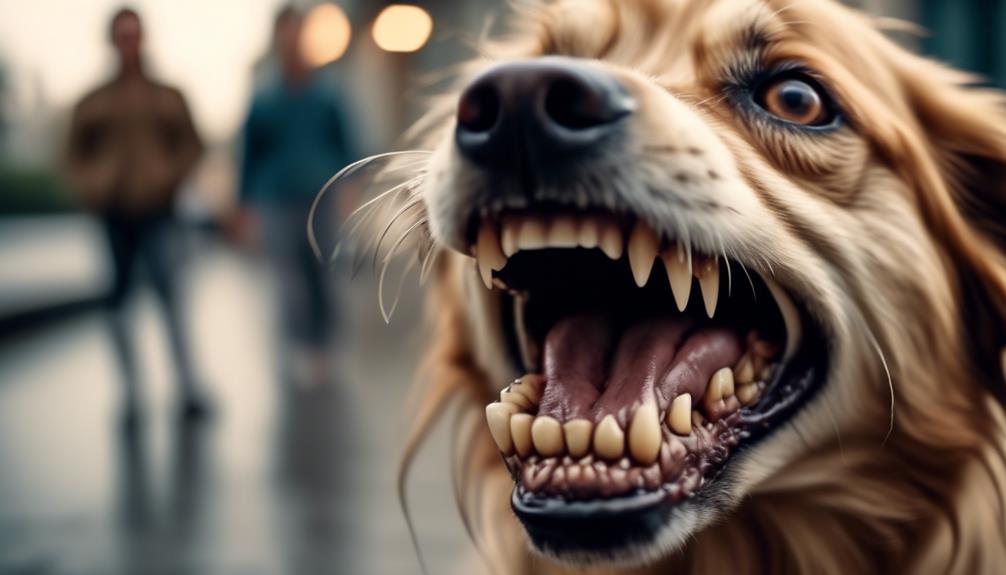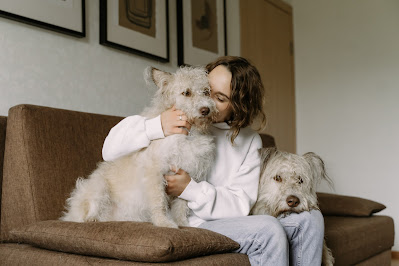Unexpected Threat: A Deep Dive Into Instances When Pets Attack

Deep Dive Into Instances When Pets Attack: You’re walking down the street, enjoying a leisurely stroll, when suddenly, out of nowhere, a pet attacks. It’s a scenario that no one wants to imagine, but one that happens more often than you might think. In this exploration of unexpected threats, we delve into the instances when pets turn aggressive and the underlying causes behind their behavior. From territorial aggression in exotic pets to the warning signs of a potential attack, we’ll uncover the secrets behind these unexpected threats. But be warned, the answers may surprise you and leave you questioning the safety of your own furry companions.
Types of Pet Attacks
When it comes to pet attacks, several different types of aggressive behaviors can be exhibited by animals. Dogs, in particular, are known for their potential to bite and display aggressive behavior. A dog bite refers to the act of a dog using its teeth to cause injury to a person or another animal. Dog attacks can range from minor nips to severe bites that result in significant harm. Aggressive behavior in dogs can be triggered by fear, territorial instincts, or feeling threatened. It is essential to understand that even domesticated and friendly pets can exhibit aggressive behavior under certain circumstances.
Aggression in dogs can manifest in various ways. Growling is a vocalization dogs use to express their displeasure or warn of an impending attack. Snapping involves a quick and forceful movement of the dog’s mouth towards the target, but without making contact. Scratching is another form of aggression that dogs may use, especially when they feel threatened or need to defend themselves. Hissing is a behavior commonly seen in cats and can indicate fear or aggression.
In Phoenix, Arizona, there have been concerns about dog bites and pet-related incidents. In 2019, there were 4,854 reported dog bites in the area, highlighting the prevalence of aggressive behavior in pets. This raises specific concerns about territorial aggression, especially in exotic pets.
Understanding the root causes of aggressive behavior in pets is crucial for managing and modifying their behavior. Factors such as fear, protectiveness, lack of socialization, and underlying medical conditions can contribute to aggressive tendencies. Seeking assistance from animal behaviorists and trainers can be beneficial in addressing and modifying aggressive behavior in pets. Responsible ownership, obedience training, spaying/neutering pets, and providing mental and physical stimulation are preventive measures that can help reduce the likelihood of pet attacks and promote safer interactions with animals.
Common Aggressive Behaviors
When it comes to common aggressive behaviors in pets, it is important to be aware of the warning signs, triggers, and causes. Understanding these factors can help you recognize when your pet may be feeling threatened or scared, and can help prevent potential incidents. Some warning signs to look out for include growling, barking, lunging, snapping, scratching, and hissing, which can occur when pets feel agitated or when their personal space is invaded. By recognizing these behaviors and addressing them with the help of professionals, such as animal behaviorists and trainers, you can ensure the safety and well-being of both your pet and others around them.
Warning Signs
Pets display various warning signs to communicate their aggression, such as growling, barking, lunging, snapping, scratching, hissing, and other aggressive behaviors. When a dog feels threatened, scared, or agitated, it may growl or bark to warn of potential threats. Lunging and snapping are also common behaviors exhibited by dogs when they feel cornered or protective. On the other hand, cats may scratch, hiss, or display aggressive behaviors when they feel scared or their personal space is invaded.
It is important to note that these warning signs should not be ignored, as they can escalate into more serious situations, including dog bites. Understanding the underlying causes of aggression, such as lack of socialization, fear, protectiveness, or medical conditions, is crucial in addressing and preventing aggressive behaviors in pets. Seeking professional assistance from pet trainers, enrolling pets in obedience training classes, and providing mental and physical stimulation can help manage and mitigate these warning signs of aggression.
Triggers and Causes
Understanding the warning signs of aggression in pets is crucial, but it is equally important to delve into the triggers and causes of these common aggressive behaviors. Aggressive behavior in pets can be triggered by various factors, including fear, protectiveness, lack of socialization, and underlying medical conditions. Dogs may growl or bark when they feel threatened, scared, or agitated while lunging or snapping can occur in dogs that are not trained or socialized properly.
On the other hand, cats may scratch and hiss when they feel cornered, scared, or when their personal space is invaded. Recognizing and addressing these triggers can help prevent aggressive behaviors and reduce the risk of dog bites and other incidents. Responsible pet ownership, which includes proper training, socialization, and addressing any medical issues, is vital in ensuring the safety of both pets and their human companions.
Territorial Aggression in Exotic Pets
Territorial aggression in exotic pets can be triggered by the need to defend their living space or resources. This behavior is not limited to aggressive dogs; it can also be observed in various exotic pets. Unlike domesticated dogs, exotic pets may display territorial aggression due to fear of unfamiliar surroundings or perceived threats. This aggression can be influenced by their natural instincts to protect their territory or assert dominance.
Understanding the specific factors that trigger territorial aggression in exotic pets is crucial for responsible ownership and their proper management and care. Exotic pets, such as reptiles, birds, or small mammals, have unique environmental and social needs that must be met to prevent the development of territorial aggression. Providing them with a suitable living space that mimics their natural habitat can help reduce stress and anxiety, which can contribute to territorial behavior.
Proper socialization and training can play a significant role in addressing and mitigating territorial aggression in exotic pets. Exposing them to various stimuli, such as different people, animals, and environments, from a young age can help them become more adaptable and less prone to aggressive behavior. Consistent and positive reinforcement training methods can also teach them appropriate behaviors and establish boundaries within their territory.
Responsible ownership of exotic pets requires a deep understanding of their unique needs and behaviors. It is essential to research and consult with experts to ensure that the pet’s environment and interactions are conducive to their well-being. By addressing the triggers of territorial aggression and providing appropriate care and training, owners can help their exotic pets live harmoniously and reduce the risk of aggressive incidents.
Understanding Animal Behavior
Understanding animal behavior is essential to prevent pet attacks. Instinctual aggression triggers, such as fear and protectiveness, can lead to aggressive behaviors like growling, lunging, and scratching. Socialization and training play a crucial role in shaping pet behavior, while recognizing warning signs and taking preventive measures, such as responsible ownership and obedience training, can help ensure a safe and harmonious relationship with your pet.
Instinctual Aggression Triggers
Pets may exhibit instinctual aggression triggers, such as fear, territorial instincts, or feeling threatened, which can lead to animal attacks. Aggressive behavior in pets, including dog bites, can stem from various factors. Fear is a common trigger, where the pet perceives a threat and reacts aggressively to protect itself. Territorial instincts can also provoke aggression, as pets may perceive intruders as a threat to their territory. Feeling threatened, whether by humans or other animals, can elicit aggressive responses as well.
It is important to note that breed tendencies can influence the likelihood of aggressive behavior, although individual temperament and upbringing play significant roles. Understanding these triggers and managing them through responsible ownership, socialization, and proper training can help prevent pet attacks. Seeking assistance from trainers and addressing any underlying medical conditions are also crucial steps in controlling aggression.
Socialization and Training
To effectively modify and understand animal behavior, it is essential to prioritize socialization and training. When it comes to dogs, proper socialization from a young age is crucial in preventing aggressive behavior. Dogs that are not adequately socialized may become fearful or anxious in unfamiliar situations, leading to potential bites. Training plays a significant role in teaching dogs appropriate behavior and helping them understand boundaries.
Through training, dogs can learn commands such as “sit,” “stay,” and “leave it,” which can be used to redirect their attention and prevent potential aggressive situations. Training also helps strengthen the bond between owners and their dogs, promoting trust and cooperation. Dog owners need to invest time and effort into training their pets to ensure they are well-behaved and less likely to bite.
Warning Signs and Prevention
Recognizing the warning signs and body language of animals can provide valuable insight into their behavior and help prevent potential attacks. When it comes to aggressive behavior in pets, there are several signs to watch out for. Growling, snapping, scratching, and hissing are all indications that a pet may become aggressive. Pet owners need to educate themselves about these signs and take proactive measures to prevent attacks.
Seeking assistance from professional trainers can be beneficial in understanding and addressing aggressive behavior in pets. Responsible pet ownership is also crucial in preventing attacks. This includes obedience training, providing proper socialization opportunities, and spaying/neutering pets. By being aware of these warning signs and taking preventive measures, you can ensure a safe and harmonious relationship with your pet.
Risk Factors and Warning Signs
Understanding the risk factors and warning signs associated with pet animal attacks is essential for responsible pet ownership. Aggressive behavior in pets can be influenced by various factors, including fear, territorial instincts, and feeling threatened. Responsible owners need to recognize and address these risk factors to prevent potential attacks.
Certain breeds may have a predisposition towards aggressive behavior, although it is important to note that not all individuals within a breed exhibit such behavior. Factors such as genetics, early socialization, and training also play a significant role in determining a pet’s behavior. It is crucial for owners to thoroughly research and understand the characteristics and tendencies of the breed they choose to bring into their homes.
Recognizing warning signs can help prevent pet attacks. Aggression in pets may manifest in various ways, such as growling, snarling, lunging, or biting. Owners need to be vigilant and observant of their pet’s behavior, especially in unfamiliar situations or when the animal displays signs of distress or discomfort.
Responsible owners should take steps to prevent aggressive behavior in their pets. This includes providing proper socialization from an early age and exposing pets to different environments, people, and animals. Regular exercise and mental stimulation are also important to prevent pent-up energy that can lead to aggression. Additionally, spaying or neutering pets can help reduce their aggression levels.
In some cases, seeking professional assistance from trainers or behavior experts may be necessary to address aggressive behavior effectively. Obedience training can help establish boundaries and reinforce positive behavior, promoting a harmonious relationship between pets and their owners.
Preventive Measures for Pet Attacks
Implementing preventive strategies and safety precautions is essential in reducing the risk of pet attacks. As responsible pet owners, it is crucial to take the necessary steps to prevent aggressive behavior in our pets. Proper training and socialization play a significant role in preventing pet attacks. Seeking assistance from pet trainers and behavior experts can help address and modify any aggressive behaviors in pets.
Enrolling pets in obedience training classes is an excellent way to reinforce positive behavior and prevent aggression. These classes provide valuable instruction on basic commands and proper behavior, helping pets learn how to interact with humans and other animals. Through consistent training and positive reinforcement, pets can develop good manners and reduce the likelihood of aggressive behavior.
Consideration should also be given to spaying or neutering pets. This procedure not only helps control the pet population but also reduces the potential for aggression. Studies have shown that intact animals are more likely to display aggressive behavior, especially in territorial or mating situations. Spaying or neutering can help mitigate these tendencies, creating a safer environment for both pets and their owners.
Additionally, responsible pet owners should be aware of their pet’s behavior and any warning signs of aggression. It is important to intervene and provide appropriate discipline or redirection when necessary. By closely monitoring our pets and addressing any signs of aggression promptly, we can prevent situations that may escalate into attacks.
Training and Socialization
To effectively prevent pet attacks, you must prioritize training and socialization to ensure that your pets develop appropriate behavior and responses to various stimuli. Training and socialization are crucial for preventing aggressive behavior in dogs and other pets.
Proper socialization plays a vital role in helping pets feel comfortable and secure in different situations. By exposing them to a wide range of people, animals, and environments, you can help them build confidence and reduce the likelihood of aggression. Socialization should start early and continue consistently throughout your pet’s life.
Training is another essential aspect of preventing pet aggression. Through training, you can teach your pets appropriate behavior and responses to different stimuli. They can learn commands such as “sit,” “stay,” and “leave it,” which can be useful in redirecting their attention and preventing potential aggressive reactions.
Early and consistent training and socialization are key to preventing aggressive behaviors in pets. By starting training from a young age, you can establish good behavior patterns and prevent the development of aggressive tendencies. Consistency is crucial, as reinforcing positive behaviors and addressing inappropriate ones consistently will help shape your pet’s behavior over time.
When training your pet, it is important to use positive reinforcement techniques. Rewarding good behavior with treats, praise, or playtime can help motivate your pet to continue displaying appropriate behavior. Conversely, punishment-based training methods can lead to fear, anxiety, and increased aggression.
Responding to Pet Attacks
When faced with a pet attack, it is crucial to respond quickly and assertively to ensure the safety of everyone involved. Understanding the root causes of aggressive behavior in pets, such as fear, territorial instincts, and feeling threatened, can help inform your response. In these situations, it is essential to prioritize the safety of yourself and others.
If you find yourself in immediate danger, it is important to try and create a barrier between you and the attacking pet. Use any available object, such as a jacket or backpack, to protect yourself. Avoid making sudden movements or loud noises, as this may further agitate the animal.
Once you are safe, it is recommended to contact animal control or the local authorities to report the incident. They can provide guidance on how to handle the situation and ensure the safety of others in the area. It is crucial to provide as much information as possible, including a description of the pet and its owner if known.
For dog owners, it is essential to understand the legal responsibilities and liabilities associated with pet attacks. In many jurisdictions, owners can be held accountable for damages caused by their dogs’ aggression. Familiarize yourself with the laws in your area to ensure you are aware of your rights and obligations.
To prevent future attacks, responsible pet ownership is key. This includes proper socialization and training from an early age. Seeking assistance from pet trainers and behavior experts can be beneficial in addressing aggressive tendencies in pets.
Dog Attack Statistics by Breed
Dog breeds vary in their tendencies and behaviors, and understanding dog attack statistics by breed can provide valuable insights into the prevalence of certain breeds in incidents involving pet aggression. While it is important to note that breed tendencies are not definitive predictors of aggression, analyzing dog attack statistics can help us gain a better understanding of the potential risks associated with specific breeds.
According to dog attack statistics, pit bulls were responsible for 66% of total fatal dog attacks between 2005 and 2017, making them the breed most commonly associated with aggressive behavior. German shepherds ranked second in terms of fatal dog attacks. However, it is crucial to remember that these statistics do not mean that all pit bulls or German shepherds are inherently aggressive. Breed tendencies can influence behavior, but individual factors such as socialization, training, and environment also play significant roles.
Approximately 4.5 million people in the US experience dog bites each year, with around 800,000 requiring medical attention for their injuries. While certain breeds, like Labrador Retrievers, are typically known for their calm demeanor and are less prone to biting, it is essential to understand that breed traits do not guarantee a dog will never exhibit aggressive behavior. Any dog, regardless of breed, can bite under specific circumstances.
Analyzing dog attack statistics by breed can help raise awareness about potential risks and guide responsible pet ownership. It is vital to remember that promoting responsible dog ownership, including proper training, socialization, and supervision, is crucial in preventing aggressive behavior in all breeds. By understanding the statistics and taking appropriate measures, we can work towards reducing the occurrence of dog attacks and promoting safer interactions between pets and humans.
Legal Implications and Responsibilities of Dog Owners
Pet owners bear legal responsibilities for the actions of their pets, including any harm caused to others. When it comes to dog ownership, there are important legal implications and responsibilities that owners must be aware of. One of the major concerns is aggressive behavior displayed by dogs, which can lead to serious consequences.
In the state of Florida, for example, dog owners are held accountable for any damages resulting from their dog’s behavior, as outlined in Chapter 767 of the state’s laws. This means that if your dog bites or attacks someone, you can potentially be liable for the injuries and damages caused.
The legal implications of dog ownership extend beyond financial liability. Dog owners can face civil penalties, criminal prosecution, and intervention by animal control authorities in the event of a dog bite incident. These measures are in place to ensure public safety and hold owners accountable for the actions of their pets.
In the event of a dog bite incident, seeking legal assistance and understanding state laws can greatly impact the outcome of the case. It is important to consult with an attorney who specializes in dog bite cases to ensure that your rights are protected and that you are aware of the legal responsibilities you have as a dog owner.
Being a responsible dog owner goes beyond providing food, shelter, and love to your pet. It also includes taking necessary precautions to prevent aggressive behavior and ensuring that your dog is properly trained and socialized. By understanding the legal implications and responsibilities of dog ownership, you can help create a safer environment for both your pet and those around you.
Deep Dive Into Instances When Pets Attack Frequently Asked Questions
What Is Idiopathic Rage Syndrome?
Idiopathic rage syndrome, or rage syndrome, is a rare condition in dogs characterized by unexplainable, explosive aggression. It can occur in certain breeds and is often misdiagnosed. Treating it is challenging and euthanasia may be necessary for safety.
What Is the Best Weapon to Defend Against a Dog Attack?
The best methods for defending against a dog attack include using non-lethal options like a sturdy object to shield yourself, pepper spray or deterrent spray, loud noise to startle the dog or even a taser for self-defense techniques.
What Is Animal Attack Without Provocation?
Without provocation, an animal attack is when a pet unexpectedly becomes aggressive towards you. Animal behavior experts can help determine why this occurred and provide prevention strategies. It’s important to understand the legal implications surrounding such incidents.
What Is the Trauma After Animal Attack?
The trauma after an animal attack can be severe. Emotional recovery may require counseling and therapy. Coping strategies are essential for dealing with fear, anxiety, and phobias. The long-term effects can include nightmares, flashbacks, and avoidance of similar situations.
Conclusion
In conclusion, understanding and managing animal behavior is crucial in preventing pet attacks. By educating ourselves about common aggressive behaviors and the warning signs, we can better respond to potential threats. Training and socialization play a vital role in reducing the occurrence of pet attacks, while responsible pet ownership and adherence to laws and regulations help protect both pets and humans. By taking these preventive measures, we can create a safer environment for everyone and minimize the high costs and potential legal consequences associated with pet attacks.








